Recebido: 9-04-2022 | Aprovado: 24-06-2022
![]() Naoufel Belhaj, Cadi Ayyad University, Marrakech, Morocco (belhaj.naoufel@gmail.com)
Naoufel Belhaj, Cadi Ayyad University, Marrakech, Morocco (belhaj.naoufel@gmail.com)
How to cite this article:
Belhaj, N. (2023). Local taxation and sustainable urban development in Morocco.
RevistaMultidisciplinar, 5(1), 55-70.
https://doi.org/10.23882/rmd.23109
Abstract: Over the last few decades, the financing of cities has been at the heart of ongoing debates of change and deep reforms as well as major concerns in all countries where decentralization is giving an increasingly dynamic role to local governments. This article presents the role of local taxation in promoting sustainable urban development in Morocco through an empirical study of 163 actors and partners involved in cities in the regions of Casablanca-Settat and Rabat-Salé-Kénitra. The results show that to increase local taxation in Morocco, it is necessary to develop the capacity of city managers, encourage public-private partnerships, and improve the quality of spending.
Keywords: local taxation, sustainable urban development, cities, Morocco.
Introduction
Sustainable
urban development is an integration of the concept of sustainable development
with an operating mode of spatial planning: urban planning. These two concepts
have a common objective, that of a harmonious development of the citizens in a
well determined space: the city, answering their needs namely: housing,
employment, education and access to leisure, in an economically attractive,
politically stable and culturally rich universe (Camagni & Gibelli, 1997).
It is also a system that independently articulates elements of the three
pillars: the economic pillar, the social pillar and the environmental pillar
(Didier, 2007, p.11), « the sustainability
approach establishes […] public policies that make it possible to articulate the
socioeconomic development and spatial planning of urban areas with careful
management of the environment» (Bochet & Cunha, 2002, p. 3).
However, to promote
sustainable urban development, to support urban growth and socio-economic
development, as well as to improve the quality of life of city dwellers, it is
necessary to seek effective and innovative financing mechanisms, appropriate
financial governance mechanisms and adapted legislative and institutional
frameworks. The objective is to promote equitable and environmentally friendly
socio-economic development, by promoting the attractiveness of cities and
supporting the creation of businesses and jobs.
Sustainable
urban development can only be conceived in a context where the local economy is
consolidated. Therefore, it is essential to establish a good quality
infrastructure environment. The realization of infrastructure and public
investment is globally through three sources (Yatta, 2014):
1.
Financial transfers from
the state to cities, which can take several forms: general allocations to
finance certain investments or support certain policies, subsidies to balance
the budgets of local governments, etc…;
2.
External resources made
up of loans;
3.
Revenue from local
privatization and public-private partnerships, which also contribute to the
financing of local public investments.
The fact
remains that mobilizing local tax potential is the key to local socio-economic
development. The weakness of the city's financial resources is more often linked
to the low actual level of local taxation than to the economic poverty of local
authorities. Several sectors of the economy are taxed very little or not at all,
while land assets do not contribute enough to local economic activity. These
findings indicate that most cities in developing countries are actually poorer
than their inhabitants. A study about local finance in these countries concluded
that it is possible to strengthen local resources considerably while maintaining
the same level of local taxation (Bahl & Linn, 1992, p. 385-427).
They argued that the less cities collect and
spend, the poorer they become, and that «They
argued that the less cities levy and spend, the poorer they become, and that
"the inability of local governments to spend creates a vicious cycle in which a
poor living environment leads to stagnation and even relative regression in the
local economy: the more cities levy and spend, the better off the local economy
becomes» (FMDV, 2014, p.12).
We will
present a review of the literature and an overview of local taxation in Morocco.
We will then present the methodology adopted and conclude with an analysis and
discussion of the results on the causes of the weakness of local taxation in
Morocco and the tools to strengthen it in order to improve the financial
autonomy of cities and promote sustainable urban development.
1. Literature Review
The
development of cities' financial resources is a major concern of local
decision-makers in order to meet the increased needs of citizens and promote the
socio-economic development of urban centers. Generally, these financial
resources are made up of own or local resources; borrowing resources; financial
contributions from the State "Ministries and Public Companies"; local
privatization revenues (asset sales, public-private partnerships, public service
concessions) and donations and bequests (FONDAFIP, 2015).
In Morocco,
the 2015 reports on local taxation by the Regional Courts of Accounts indicate
that there is significant urban tax potential, but its exploitation is very
weak, both in terms of the tax base and collection. Indeed, economic development
and rapid urban growth are not reflected in local tax revenues (Cour des Comptes, 2015). According to the situation of
revenues and expenditures of local governments in 2022, the resources
transferred by the State to local governments, consisting mainly of their share
in the prοduct of VAT, represent (56,7 %) of all local
tax revenues, followed by resources managed directly by the municipalities (33,7
%), then by resources managed by state services for the benefit of local
governments (9,6 %) (TGR, 2022). This reveals that the cities depend heavily on
financial support from the state (FONDAFIP, 2015). As a result, local
governments must make more efforts to develop their own sources of revenue.
Table 1
Evolution of local government resources between 2021 and 2022 in millions of
dirhams and in %.
|
Local
government resources |
|||
|
|
2021 |
2022 |
Evol. |
|
Transferred
resources |
2 186 |
2 084 |
- 4,7 % |
|
Resources
managed by state services for the benefit of local governments |
515 |
354 |
- 31,3 % |
|
Resources
managed directly by the municipalities |
1 147 |
1 238 |
7,9 % |
|
Total |
3 848 |
3 676 |
- 4,5 % |
Source : TGR, 2022
This inadequacy of local finances in Morocco is
mainly due to a low level of local tax revenue, a higher level of operating
expenditure than investment expenditure and the inability to achieve the full
investment budget (FONDAFIP, 2015).
1.1.
Low yield from local taxation
According to a report by the Regional Courts of Accounts on the
evaluation of local taxation, the own tax resources of urban communes cover only
54% of operating expenses; the remainder is financed essentially by the VAT
transferred by the State (Cour
des Comptes, 2015). This low yield of local
taxation is mainly due to the absence of local tax application circulars (FMDV,
2014), the lack of collection of local debts, the weak use of information
technology and exploitation of databases (Safir, 2015), the lack of qualified
human resources capable of managing the local tax base and monitoring their
collection (FONDAFIP, 2015), the lack of accountability, responsibility, and
coordination between the different actors in the city, as well as the low
quality of public services (Dedehouanou,
2019).
1.2.
The superiority of operating expenditures over investment expenditures
The
evolution of the structure of local government spending between 2021 and 2022
shows an increase in the share of equipment spending and investment spending,
combined with a decrease in the share of personnel spending and debt interest
charges, as shown in the following figure: (TGR, 2022).
Figure 1
Structure of overall expenditure of local authorities between 2021 and 2022 in %
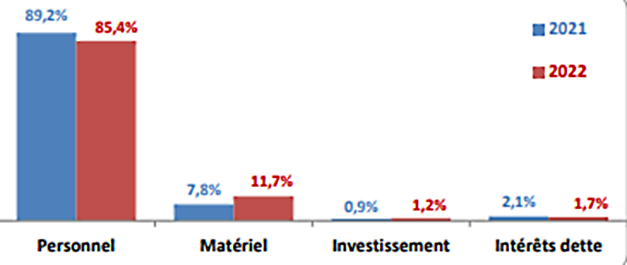
Source : TGR, 2022
1.1.
The inability to achieve the full investment budget
In
Moroccan cities, investment needs are very high. Indeed, local managers do not
always realize the full amount of their investment budgets, which usually
results in surpluses that are carried over from year to year (FONDAFIP, 2015).
According to a report by the Consultative Commission on Regionalization,
surpluses from previous years (carryovers), in 2014, reached 23,4 billion
dirhams (CCR, 2014).
According to a report on the financing of African cities, Moroccan
municipalities are characterized by a very low absorption capacity and do not
carry out their entire investment budgets. In fact, they often have surpluses of
30 to 40 percent compared to the amount of investments made (Paulais, 2012).
1.2.
Significant budget transfers from the State to the cities
Moroccan cities regularly receive tax transfers from the State on the basis of
simple, transparent and objective criteria, aimed at encouraging them to develop
their own local resources, improve their propensity to invest, meet citizens'
needs in terms of infrastructure and public services and achieve socio-economic
promotion of urban centers.
The
state is the main provider of financial resources to cities through the
allocation of 30 percent of the proceeds of the VAT as well as through the
institution of new taxes and fees. Any increase in state revenue systematically
generates an increase in the resources transferred to cities, and any decrease
automatically results in a loss of value (FONDAFIP, 2015).
This
weakness in the yield of local taxation, obliges local governments to seek
innovative financing to improve the profitability of local finances. Local
assets can therefore be an alternative that can compensate for the weakness of
tax resources.
Along with these challenges, we can add:
·
The existence of spatial and socio-economic
inequalities between municipalities (Raiss, 1999);
·
Inequality in the distribution of resources between
the State and local authorities (Yatta, 2014);
·
The absence of information systems (FONDAFIP,
2015);
·
The presence of a very large informal economy (FMDV,
2014);
·
Weaknesses in accounting and budget management ;
·
Weak control of local finances and identification of
taxpayers;
·
A low level of income among the local population
(PFVT, 2017);
·
Weak capacity of local government;
·
Low exploitation of local taxes;
·
Low exploitation of some local taxes, such as
property tax (FONDAFIP, 2015);
·
A lack of autonomy in determining the tax base and
rates (Yatta, 2014);
·
Irrationality in the allocation of local expenditures
(Agoumy
& Refass, 2012);
·
The lack of rationality in the overall management of human resources
(Safir, 2015);
·
The absence of a consolidated vision of revenues and expenditures for city
management;
·
A less developed institutional framework in favor of cities (FMDV, 2014);
·
Political resistance to descentralization ;
·
Weak identification and mobilization of cities' fiscal potential (Cour des Comptes,
2015);
·
Low local debt collection;
·
Low participation of the private sector in the financing and production of
the city (FONDAFIP, 2015);
·
Weak coordination between the various city actors (Beaupuy, 2008);
·
The absence of tools for good governance of local resources (Habitat III,
2016).
2. Materials & Methodology
Our
sample is made up of 163 actors and partners involved in the cities in the
regions of Casablanca-Settat and Rabat-Sale-Kenitra. It is composed of 45 local
authorities, 6 national actors, 31 public institutions and companies, 18
regional and local actors, 7 international actors, 31 associations and 25
private companies. This sample is well distributed across the survey regions, as
shown in the table and graph below.
Table 2: Survey sample
|
who are
you? |
Number of observations |
Frequency |
|
Local authority |
45 |
27,6% |
|
National actor |
6 |
3,6% |
|
Regional and/or local actor |
18 |
11,4% |
|
Association |
31 |
19% |
|
Private company |
25 |
15,4% |
|
Public institution or company |
31 |
19% |
|
International actor |
7 |
4% |
|
Total |
163 |
100% |
Figure 2
Distribution of the sample between the regions of Casablanca-Settat
and Rabat-Sale-Kenitra
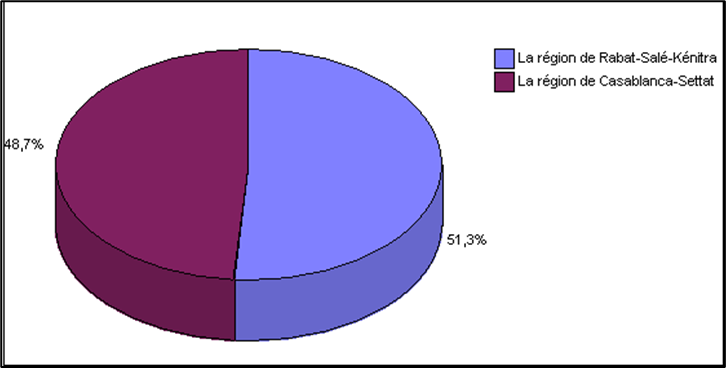
These data were processed using an exploratory data analysis method. We
used the stratified random sampling method, which gives the same chances to all
the units in the population and allows us to generalize the results obtained
from the sample.
In our case, the strata, which are heterogeneous groups, correspond to
the groups of actors: national actors, international actors, regional and local
actors, local authorities, civil society and private companies.
Among the 12 regions of the Kingdom, we chose the regions of
Rabat-Salé-Kénitra and Casablanca-Settat for several reasons, particularly their
demographic and economic weight compared to the other regions. Demographically,
the Rabat-Sale-Kenitra and Casablanca-Settat regions have 11,442,605
inhabitants, or 33.8 percent of the Moroccan population (HCP, 2014).
Economically, the regions of Casablanca-Settat and Rabat-Salé-Kénitra
create the most wealth and contributed the most to the national GDP in 2014,
These two regions alone contributed 48.3% of the national GDP (TGR, 2022).
Table 3
Distribution of local government revenues by region
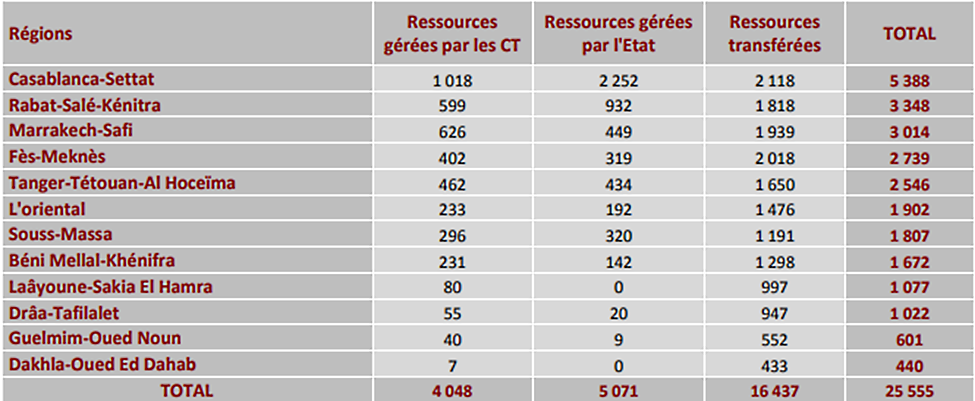
Despite their economic and demographic potential, these two regions depend heavily on financial support from the state and have a relatively low level of local taxation, hence the need for a profound review of the financial governance of the cities in these regions, in order to mobilize more resources and manage them better.
Table 4
Weight of local taxation in the budget of Casablanca-Settat and
Rabat-Sale-Kenitra regions in 2019, in millions of dirhams
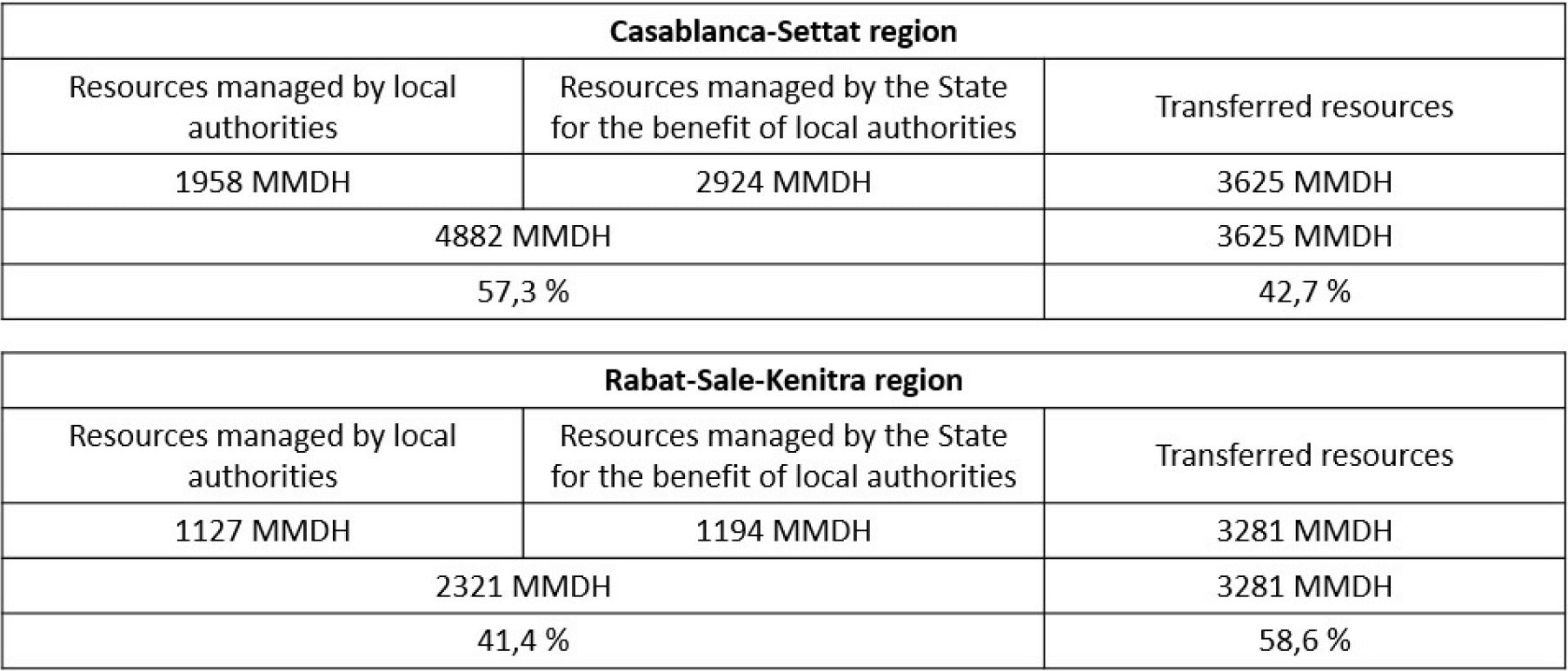
Source: Author
3. Results, analysis and discussion
Local taxation represents an important part of the fiscal resources for local
governments, the other part being paid by the State within the framework of
decentralization laws. Local taxation concerns several urban sectors such as:
real estate, administrative, industrial, commercial, professional, transport,
tourism, etc.. (FMDV, 2014).
Cities in Morocco are highly dependent on financial support from the state and
are subject to the mutations and effects of globalization by transitivity. They
are influenced by the effects of the mobility of tax bases, due to the erosion
of the tax base and the transfer of profits. Almost 86% of the financial
resources of local authorities come essentially from revenues transferred or
managed by the State. This heavy dependence on state allocations puts local
governments at risk if the state's public finances do not generate sufficient
resources (FONDAFIP, 2019).
Among the shortcomings detected, almost all of the actors interviewed affirm
that there is significant fiscal potential in cities, but that it is poorly
exploited. The development generated by rapid urbanization and economic growth
is not reflected in local tax revenues. They also claim that the financial
resources available to cities are not sufficient to meet the needs of citizens,
that the annual investment budget is not sufficient, and that the distribution
of local expenditures is not equitable.
Table 5
City actors' perception of local taxation
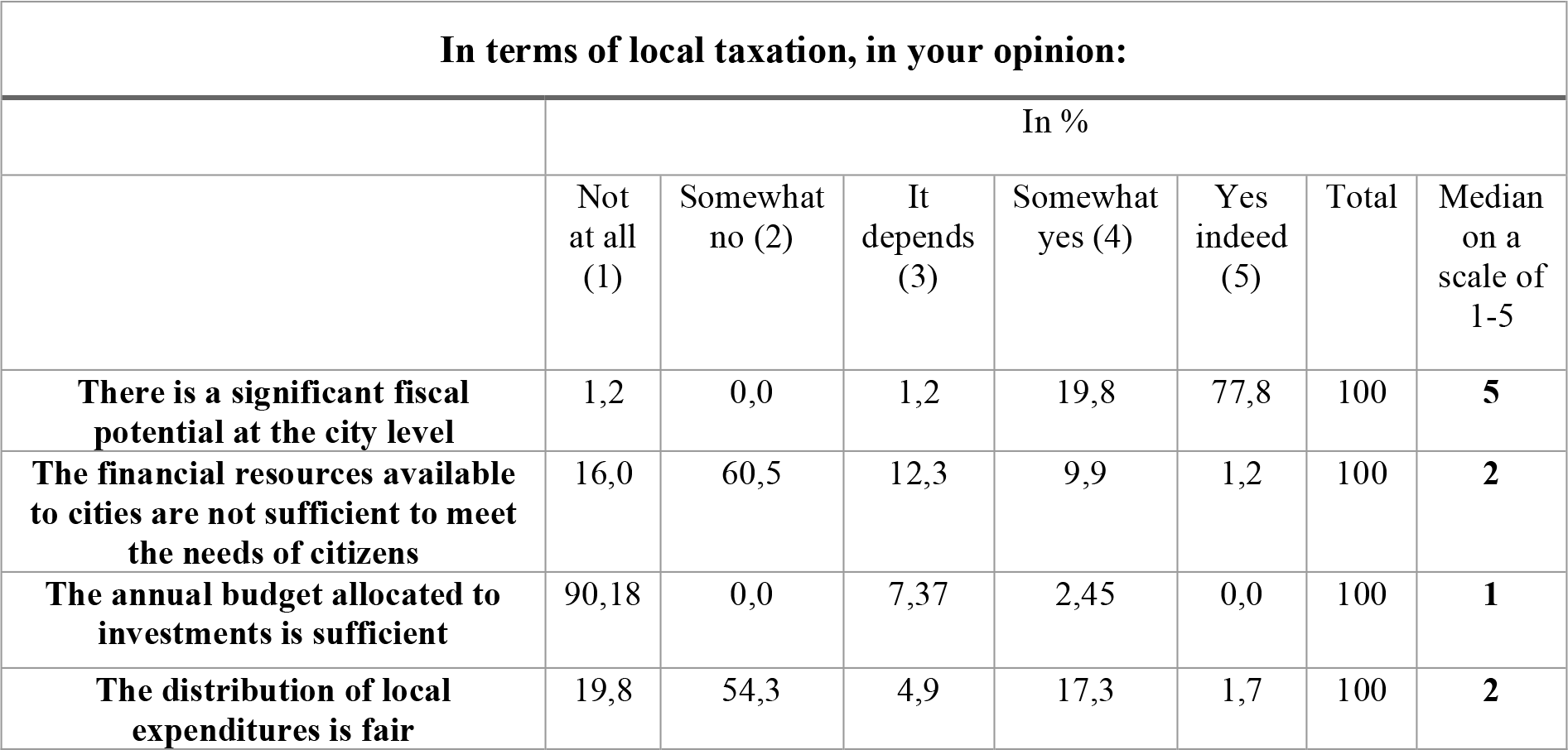
The actors interviewed said that in order to
develop the financial resources of cities, it is necessary to improve the base
and/or rates of local taxes, increase local fees, improve the collection of
local taxes, encourage borrowing and strengthen public-private partnerships.
They also affirmed that it is the real estate sector that brings in the most
revenue from local taxation (taxes on edifices, constructions, subdivisions,
subdivision operations and undeveloped land), followed by the industrial sector
and finally the commercial sector.
Other questions were asked only to the local
authorities in order to find out what tools they use to make taxpayers aware of
the payment of local taxes, among the tools mentioned we can mention
communication around projects and sources of financing, dialogue with
representatives of the different professions, the intervention of the tax
department and legal tools, etc...
The local authorities also mention that they
have difficulties in identifying taxpayers, this is mainly due to the lack of an
updated database, the low tax civic-mindedness of citizens, internal fraud and
the low collaboration of taxpayers.
Also, local authorities say that they do not
have sufficiently qualified human resources to manage the local tax base and
monitor their collection, and that they do not make sufficient use of
information, communication and database technologies.
In order to increase a city's financial
autonomy, it is necessary to guarantee sufficient financial resources to local
managers to enable them to carry out their missions, and among them, local
taxation. The financing of investments, goods and public facilities is ensured
by local authorities through the collection of local taxes. A positive dynamism
of tax revenues makes it possible to constitute the guarantees necessary to
mobilize additional funds. In addition, local taxation aims to reduce
inequalities through the redistribution of income from assets and economic
activity within the city. It plays a central role in strengthening the city's
financial autonomy, in the structure of local budgets and in the construction of
local democratic life (AREA, 2003).
Therefore, in order to obtain additional
financing, local and regional governments must be made more attractive to
investors (a solid fiscal base and good local financial governance). In addition
to private operators, cities need to diversify their sources of funding,
especially from international donors (international markets, finance companies
and commercial banks). This allows them to mobilize significant funds to finance
large-scale projects.
Improving the quality of spending contributes to citizens' acceptance of
taxes. "The inability of local governments to spend creates a vicious cycle
in which a poor living environment leads to stagnation or even relative
regression in the local economy: the less a city levies and spends, the poorer
everyone ends up being" (FMDV, 2014, p.12). Cities can double or even triple
the level of levies and spending to make the local economy better off. But such
an ambition requires dialogue between local managers and local
socio-professional groups, as well as efficient and transparent management of
the resources collected. Managers need to balance elective and participatory
democracy to increase fiscal efficiency: citizens have more incentive to pay for
services that meet their priorities, especially if they have been involved in
the decision-making process regarding the provision of these services.
Improving the quality of spending is closely linked to the establishment
of effective systems of local financial control to ensure good local management.
The local tax system applied to land, buildings, subdivisions and
undeveloped land makes it possible to mobilize significant resources and to
finance public urban development facilities, such as roads, networks and
infrastructure. These expenses are so important that they cannot be covered
solely by local taxation, nor by the local authority budget. It is therefore
necessary to think about new and innovative financing mechanisms to involve
private operators in the financing of public facilities. These mechanisms would
make it possible to mobilize additional resources within contractually
negotiated frameworks and to improve the effectiveness and efficiency of the
construction of these facilities.
Improving local taxation also requires developing the capacities of city
managers and the skills of local authorities in defining the tax base and tax
rates. The city must therefore support and develop the capacities of local
managers (elected officials, executives, financial managers) through training
and the use of intermediaries and experts, "Our cities today have a greater
need for competent and qualified manager-strategists, capable of transforming
our cities into islands of prosperity, expertise, competitiveness and innovation"
(FONDAFIP, 2015). This will allow the city to improve the effectiveness of
the consultation of these local actors, and thus improve the mobilization and
management of local assets.
The main contribution of this publication is to confirm the positive
impact of improving local taxation on city financing and thus on sustainable
urban development. It is therefore essential to develop the capacities of city
managers, encourage public-private partnerships and improve the quality of
expenditure.
Conclusion
Local taxation in cities in developing countries has many shortcomings, and its
revenue does not sufficiently feed the local budget. This is due to a number of
factors, including the existence of a less developed institutional framework for
cities, a low level of income among citizens, poor use of some local taxes,
inequality in the distribution of resources between the central government and
local authorities, political opposition to decentralization, erosion of the tax
base due to certain national policies, weak autonomy of local authorities, weak
local government capacity, and lack of confidence in local authorities on the
part of citizens and investors (AREA, 2003). In these countries, the collection
of local taxes is often poor, mainly due to the lack of suitable instruments for
determining tax potential, the complexity of tax assessment methods and the
definition of the tax base, and the difficulties of issuing tax rolls and
collecting them.
In
most developing countries, it is the state that determines the base, rate and
basis of local taxes. Thus, cities are entirely passive in determining what
constitutes the basis of their financial autonomy. Generally, there is no
contractual relationship between the state departments and the local governments
for which they are supposed to work. The latter have no possibility of reacting
to underperformance on the part of the state departments (Jnah, 2018).
Nowadays, financing has become a fundamental element in the problem of urban
governance. Indeed, urban sprawl, spatial dispersion, concentration of
employment locations, and movement of inhabitants often pose a problem of
financing public services and infrastructure (OCDE, 2019). There is a need to
provide cities with the necessary and sufficient funds to meet the increased
expectations and needs of citizens and businesses. Cities must therefore
consider, in coordination with relevant stakeholders and the local population,
operational taxation strategies to mobilize financial resources that will allow
them to meet the expectations and needs of their residents and properly carry
out their missions (FONDAFIP, 2015).
The
problem of financing cities is not only about the availability of financial
resources, but also about their mobilization, management and direction (FMDV,
2014). Therefore, cities must effectively manage local financial resources while
adhering to the principles of integrity, transparency, participation, democracy,
accountability and equity (Moindze, 2010). Furthermore, the implementation of
sustainable urban development must be accompanied by sufficient financial
resources and appropriate governance of these resources. The objective is to
promote the socio-economic development of cities, fostering their attractiveness
and competitiveness and supporting the creation of businesses and jobs.
Strengthening the financial system of Moroccan cities and regions requires a
more balanced sharing of powers and financial resources between the State and
local authorities. It is necessary to encourage local authorities to broaden the
tax base and develop their local taxation, to increase borrowing and to seek
effective and innovative financing mechanisms, appropriate financial governance
mechanisms and suitable legislative and institutional frameworks. These
principles are all assets that confront the budgets of cities and regions and
that will make it possible to improve regional finances without increasing the
financial burden on the State. In this perspective, the encouragement of
investment and the creation of wealth are closely linked to national, regional
and local economic development.
References
Agoumy, T., & Refass, M. (2012). Ville et environnement durable en Afrique et
au Moyen-Orient. Publications de la Faculté des Lettres et des Sciences
Humaines, Rabat.
AREA, Atelier de Recherches, d’Etudes et d’Architecture (2003). Etude
relative au financement et à la maîtrise du coût de l’urbanisation.
Commanditaire : Ministère chargé de l’Habitat et de l’Urbanisme, Direction de
l’Urbanisme, Maroc.
Bahl, R. W., & Linn, J. F. (1992). Urban public finance in developing
countries. The World Bank.
Beaupuy, J-M. (2008). Bâtir des villes durables. Yves Michel, Paris.
Bochet B., & Cunha A. (2002). Développement urbain durable. Vues sur la ville,
(1), 3-5.
Commission Consultative de la
Régionalisation (CCR), Rapport sur la régionalisation avancée, 2014, [en ligne],
https://bit.ly/3A4URPV
Cour des Comptes (Ed.) (2015). La fiscalité locale : synthèse. Royaume du
Maroc. https://bit.ly/3QO6MHJ
Didier C. (2007). Le développement urbain durable : pour une approche
différente de la vie urbaine. Thèse de doctorat sous la direction du
Professeur Bernard LAMIZET, Soutenue le 30 août 2007, Université Lyon 2,
Institut d'Etudes Politiques de Lyon.
FMDV (2014). Renforcer les recettes fiscales locales pour financer le
développement urbain en Afrique, Paroles d’acteurs locaux - Etude de cas des
stratégies de 8 villes africaines. Fonds Mondial pour le Développement des
Villes & Ministère des Affaires Etrangères Français. https://bit.ly/3OFuILt
FONDAFIP (2015). La gouvernance financière au Maroc et en France. 9éme
édition du Colloque International des Finances publiques, Rabat.
Habitat III (2016, Mars 9-11). Financement du Développement Urbain : Le Défi
du Millénaires. Réunion Thématique d’Habitat III, Note de synthèse, México
City.
HCP (2014). Recensement Général de la Population et de l'Habitat de 2014.
Haut-Commissariat au Plan
HCP (2018). Le Maroc en Chiffres. Haut-Commissariat au Plan
Moindze, M. (2010). Les standards internationaux de la bonne gouvernance des
finances publiques. https://bit.ly/3y0HWMq
OCDE (2010). Conduire les politiques de développement régional ; Les
indicateurs de performance. OCDE.
PFVT, Partenariat Français pour
les Villes et les Territoires (2017). Le financement local, condition du
développement territorial durable et inclusif. conférence Habitat III vers
la définition d’un nouvel agenda urbain.
Safir, K. (2015). Casablanca, Hub Financier International Connecté et Inclusif.
9ème édition du Colloque International des Finances publiques, Rabat.
Trésorerie Générale du Royaume (TGR) (2022). Bulletin mensuel des
statistiques des finances locales. TRG.
Yatta,
F. P. (2014). La gouvernance financière locale. Partenariat pour le
développement Municipal (PDM). https://bit.ly/3neSIth